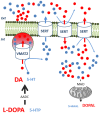Impairment of Serotonergic Transmission by the Antiparkinsonian Drug L-DOPA: Mechanisms and Clinical Implications
- PMID: 28955204
- PMCID: PMC5600927
- DOI: 10.3389/fncel.2017.00274
Impairment of Serotonergic Transmission by the Antiparkinsonian Drug L-DOPA: Mechanisms and Clinical Implications
Abstract
The link between the anti-Parkinsonian drug L-3,4-dihydroxyphenylalanine (L-DOPA) and the serotonergic (5-HT) system has been long established and has received increased attention during the last decade. Most studies have focused on the fact that L-DOPA can be transformed into dopamine (DA) and released from 5-HT terminals, which is especially important for the management of L-DOPA-induced dyskinesia. In patients, treatment using L-DOPA also impacts 5-HT neurotransmission; however, few studies have investigated the mechanisms of this effect. The purpose of this review is to summarize the electrophysiological and neurochemical data concerning the effects of L-DOPA on 5-HT cell function. This review will argue that L-DOPA disrupts the link between the electrical activity of 5-HT neurons and 5-HT release as well as that between 5-HT release and extracellular 5-HT levels. These effects are caused by the actions of L-DOPA and DA in 5-HT neurons, which affect 5-HT neurotransmission from the biosynthesis of 5-HT to the impairment of the 5-HT transporter. The interaction between L-DOPA and 5-HT transmission is especially relevant in those Parkinson's disease (PD) patients that suffer dyskinesia, comorbid anxiety or depression, since the efficacy of antidepressants or 5-HT compounds may be affected.
Keywords: Parkinson’s disease; depression; dopamine; dyskinesia; electrophysiology; exocytosis; intracerebral microdialysis; serotonin.
Figures


Similar articles
-
L-DOPA in Parkinson's Disease: Looking at the "False" Neurotransmitters and Their Meaning.Int J Mol Sci. 2019 Dec 31;21(1):294. doi: 10.3390/ijms21010294. Int J Mol Sci. 2019. PMID: 31906250 Free PMC article. Review.
-
Regulation of dopamine neurotransmission from serotonergic neurons by ectopic expression of the dopamine D2 autoreceptor blocks levodopa-induced dyskinesia.Acta Neuropathol Commun. 2019 Jan 15;7(1):8. doi: 10.1186/s40478-018-0653-7. Acta Neuropathol Commun. 2019. PMID: 30646956 Free PMC article.
-
Chronic L-DOPA therapy alters central serotonergic function and L-DOPA-induced dopamine release in a region-dependent manner in a rat model of Parkinson's disease.Neurobiol Dis. 2011 Feb;41(2):585-90. doi: 10.1016/j.nbd.2010.11.007. Epub 2010 Nov 16. Neurobiol Dis. 2011. PMID: 21092759
-
Impact of dopamine to serotonin cell ratio in transplants on behavioral recovery and L-DOPA-induced dyskinesia.Neurobiol Dis. 2011 Sep;43(3):576-87. doi: 10.1016/j.nbd.2011.05.004. Epub 2011 May 13. Neurobiol Dis. 2011. PMID: 21600983
-
L-DOPA and serotonergic neurons: functional implication and therapeutic perspectives in Parkinson's disease.Cent Nerv Syst Agents Med Chem. 2011 Dec 1;11(4):305-20. doi: 10.2174/1871524911106040305. Cent Nerv Syst Agents Med Chem. 2011. PMID: 22117594 Review.
Cited by
-
Sex Disparities in the Self-Evaluation of Subthalamic Deep Brain Stimulation Effects on Mood and Personality in Parkinson's Disease Patients.Front Neurol. 2020 Jul 31;11:776. doi: 10.3389/fneur.2020.00776. eCollection 2020. Front Neurol. 2020. PMID: 32849228 Free PMC article.
-
The Noradrenergic System in Parkinson's Disease.Front Pharmacol. 2020 Apr 8;11:435. doi: 10.3389/fphar.2020.00435. eCollection 2020. Front Pharmacol. 2020. PMID: 32322208 Free PMC article. Review.
-
Levodopa Rescues Retinal Function in the Transgenic A53T Alpha-Synuclein Model of Parkinson's Disease.Biomedicines. 2024 Jan 8;12(1):130. doi: 10.3390/biomedicines12010130. Biomedicines. 2024. PMID: 38255235 Free PMC article.
-
Behavioral and neurochemical interactions of the tricyclic antidepressant drug desipramine with L-DOPA in 6-OHDA-lesioned rats. Implications for motor and psychiatric functions in Parkinson's disease.Psychopharmacology (Berl). 2022 Nov;239(11):3633-3656. doi: 10.1007/s00213-022-06238-x. Epub 2022 Sep 30. Psychopharmacology (Berl). 2022. PMID: 36178508 Free PMC article.
-
L-DOPA in Parkinson's Disease: Looking at the "False" Neurotransmitters and Their Meaning.Int J Mol Sci. 2019 Dec 31;21(1):294. doi: 10.3390/ijms21010294. Int J Mol Sci. 2019. PMID: 31906250 Free PMC article. Review.
References
-
- Biggs C. S., Starr M. S. (1999). Microdialysis study of the effects of the antiparkinsonian drug budipine on L-DOPA-induced release of dopamine and 5-hydroxytryptamine by rat substantia nigra and corpus striatum. Synapse 34, 36–46. 10.1002/(sici)1098-2396(199910)34:1<36::aid-syn5>3.3.co;2-7 - DOI - PubMed
Publication types
LinkOut - more resources
Full Text Sources
Other Literature Sources

